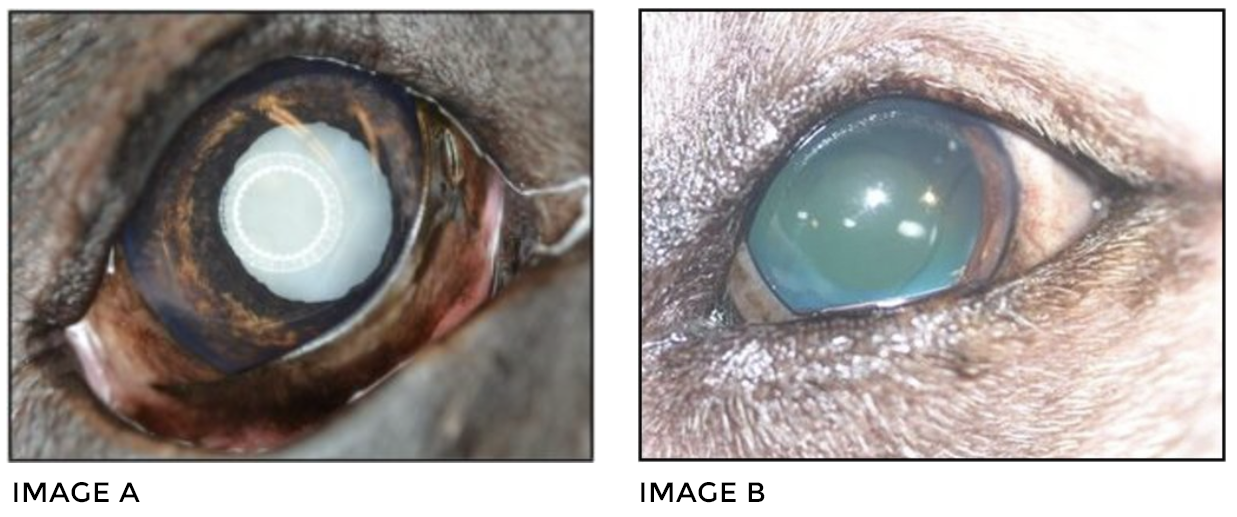Cataracts and Cataract Surgery
By Rachel Mathes, DVM, MS, Diplomate ACVO
FACTS ABOUT CATARACTS
- Inherited cataracts are the most common type in dogs
- 50% of diabetic dogs get cataracts within 6 mos and 80% of diabetic dogs within 16 mos of diagnosis
- Success rate of cataract surgery is 90-95%
- Best surgical outcome is associated with immature cataracts prior to complete blindness
Cataracts, or opacities of the lens, occur commonly in dogs and are most often inherited. The second most leading cause of cataracts in dogs is canine diabetes mellitus. Feline cataracts are typically secondary to underlying systemic or ocular pathology and are much less common than canine cataracts. Cataracts may cause vision loss or progress to total blindness. In addition, cataracts may cause other ocular complications such as chronic uveitis, retinal detachments, and glaucoma. Cataracts may be unpredictable and variable in their progression. The treatment for cataracts causing vision loss is small-incision cataract surgery performed by phacoemulsification and aspiration with placement of an artificial lens to achieve emmetropia (normal focusing power) (1,2). No medical therapy has been shown to treat cataracts.
Cataract surgery has dramatically improved in human and veterinary medicine in the last several decades with small-incisional (~3mm) surgery becoming the standard of care. Phacoemulsification or phacofragmentation of the lens with automated aspiration has replaced more archaic intracapsular lens extraction surgeries (1,3). The success rate for cataract surgery is very high with overall estimates at 90-95% short term and 85-95% long term (1,4). Certain breeds such as Labradors, Cocker Spaniels and Boston Terriers have been identified as having a higher risk of complications after cataract surgery, however, the overall complication rate is still low (2,4). Complications after cataract surgery may include retinal detachments, glaucoma, uveitis, corneal ulceration and chronic intraocular inflammation with fibrovascular membrane formation. Hypermature cataracts have been associated with a higher postoperative incidence of glaucoma (4). Immature cataracts have a lower incidence postoperatively of complications than mature and hypermature cataracts (1,3,4). In addition, subjectively, the adjustment period to normal vision after surgery is shorter and smoother for patients that are not completely blind prior to cataract surgery.
The overall client satisfaction with cataract surgery is also very high, being around 85-90%. Dissatisfaction was associated with failure to have regularly scheduled rechecks performed with the cataract surgeon. Therefore, long-term rechecks are emphasized for any client having cataract surgery performed in their pet. Cataract surgery has a high success rate and is a viable therapy for restoration of vision for patients with blinding cataracts.

A patient with a blinding, mature cataract is depicted (A). Notice the iridal darkening from chronic uveitis and complete lens opacity. A patient one day after cataract surgery is shown (B). Note the translucent artificial lens and overall comfort. This patient’s vision was restored following cataract removal.
REFERENCES
- Miller TR, et al. Phacofragmentation and aspiration for cataract extraction in dogs: 56 cases (1980-1984). J Am Vet Med Assoc. 1987; 190: 1577-80.
- Klein HE, et al. Postoperative complications and visual outcomes of phacoemulsification in 103 dogs (179 eyes): 2006-2008.
- 3Sigle KJ, Nasisse MP. Long-term complications after phacoemulsification for cataract removal in dogs: 172 eyes (1995-2002). J Am Vet Med Assoc. 2006; 228: 74-9.
- Biros DJ, et al. Development of glaucoma after cataract surgery in dogs: 220 cases. J Am Vet Med Assoc. 2000; 216: 1780-6..
- Appel SL, et al. Evaluation of client perceptions concerning the outcome of cataract surgery in dogs. J Am Vet Med Assoc. 2006; 228: 870-5.